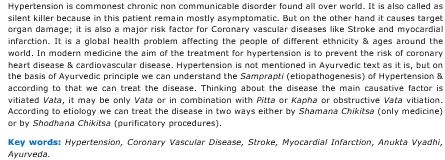Ayurvedic management of Hypertension
Keywords:
Hypertension, Coronary Vascular Disease, Stroke, Myocardial Infarction, Anukta Vyadhi, Ayurveda.Abstract
Hypertension is commonest chronic non communicable disorder found all over world. It is also called as silent killer because in this patient remain mostly asymptomatic. But on the other hand it causes target organ damage; it is also a major risk factor for Coronary vascular diseases like Stroke and myocardial infarction. It is a global health problem affecting the people of different ethnicity & ages around the world. In modern medicine the aim of the treatment for hypertension is to prevent the risk of coronary heart disease & cardiovascular disease. Hypertension is not mentioned in Ayurvedic text as it is, but on the basis of Ayurvedic principle we can understand the Samprapti (etiopathogenesis) of Hypertension & according to that we can treat the disease. Thinking about the disease the main causative factor is vitiated Vata, it may be only Vata or in combination with Pitta or Kapha or obstructive Vata vitiation. According to etiology we can treat the disease in two ways either by Shamana Chikitsa (only medicine) or by Shodhana Chikitsa (purificatory procedures).
Downloads
References
Harrisons Principles of Internal Medicine, Vol 2, Hypertensive Vascular Disease, Chapter 241, 9th edition, p1549.
API Textbook of Medicine, Vol. 1, Hypertension, Section 12.
Davidson’s Principles and Practice of Medicine, Cardiovascular diseases, Chapter 18, 21st edition, p. 580
Charaka, Charaka Samhita, Acharya Y.T. (editor), Chaukhamba Surbharati Prakashana, Varanasi. Reprint 2008, Sutrasthana 20/11, p113.
Charaka, Charaka Samhita, Acharya Y.T. (editor), Chaukhamba Surbharati Prakashana, Varanasi. Reprint 2008, Sutrasthana 20/14, p. 114
Charaka, Charaka Samhita, Acharya Y.T. (editor), Chaukhamba Surbharati Prakashana, Varanasi. Reprint 2008, Sutrasthana 20/17, p. 115
Charaka, Charaka Samhita, Acharya Y.T. (editor), Chaukhamba Surbharati Prakashana, Varanasi. Reprint 2008, Sutrasthana 12/08, p. 79
Charaka, Charaka Samhita, Acharya Y.T. (editor), Chaukhamba Surbharati Prakashana, Varanasi. Reprint 2008, Chikitsasthana 28/185-86, p. 624
Charaka, Charaka Samhita, Acharya Y.T. (editor), Chaukhamba Surbharati Prakashana, Varanasi. Reprint 2008, Sutrasthana 16/5-10, p96-97.
Ayurmedinfo
Anonymus, Rasatantrasar and Siddhaprayoga Sangraha Pan 1, Krishnagopal Ayurved Bhavan, Kaleda Krishnagopala, 23rd edition. 2014, p250.















